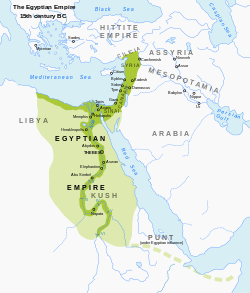New Kingdom of Egypt | |||||||||
|---|---|---|---|---|---|---|---|---|---|
| c. 1570 BC–c. 1069 BC | |||||||||
 Egyptian territory under the New Kingdom, c. 15th century BC | |||||||||
| Capital |
| ||||||||
| Common languages | Egyptian, Nubian, Canaanite, Amorite | ||||||||
| Religion |
| ||||||||
| Government | Divine absolute monarchy | ||||||||
| Pharaoh | |||||||||
• c. 1570 – 1525 BC | Ahmose I (first) | ||||||||
• c. 1107 – 1077 BC | Ramesses XI (last) | ||||||||
| History | |||||||||
• Rise | c. 1570 BC | ||||||||
• Downfall | c. 1069 BC | ||||||||
| Population | |||||||||
• c. 13th century BCE | 3[1] to 5[2] million | ||||||||
| |||||||||
| History of Egypt |
|---|
 |
|
|
The New Kingdom, also called the Egyptian New kingdom Empire, refers to ancient Egypt between the 16th century BC and the 11th century BC. This period of ancient Egyptian history covers the Eighteenth, Nineteenth, and Twentieth dynasties. Through radiocarbon dating, the establishment of the New Kingdom has been placed between 1570 BC and 1544 BC.[3] The New Kingdom followed the Second Intermediate Period and was succeeded by the Third Intermediate Period. It was the most prosperous time for the Egyptian people and marked the peak of Egypt's power.[4]
In 1845, the concept of a "New Kingdom" as one of three "golden ages" was coined by German scholar Christian Charles Josias von Bunsen; the original definition would evolve significantly throughout the 19th and 20th centuries.[5] The later part of this period, under the Nineteenth Dynasty (1295–1189 BC) and the Twentieth Dynasty (1189–1069 BC), is also known as the Ramesside period. It is named after the eleven pharaohs who took the name Ramesses, after Ramesses I, who founded the Nineteenth Dynasty, and his grandson Ramesses II, who was its longest-reigning monarch.[4]
Possibly as a result of the foreign rule of the Hyksos during the Second Intermediate Period, the New Kingdom saw a historic expansion into the Levant, thus marking Egypt's greatest territorial extent. Similarly, in response to attacks by the Kushites, who led raids into Egypt during the Second Intermediate Period,[6][7] the rulers of the New Kingdom felt compelled to expand far into Nubia and to hold wider territories in the Near East, particularly on the Levantine frontier.
- ^ Alan K. Bowman (22 October 2020). "Ancient Egypt". Encyclopædia Britannica. Retrieved 3 January 2021.
- ^ Steven Snape (16 March 2019). "Estimating Population in Ancient Egypt". Retrieved 5 January 2021.
- ^ Ramsey, Christopher Bronk; Dee, Michael W.; Rowland, Joanne M.; Higham, Thomas F. G.; Harris, Stephen A.; Brock, Fiona; Quiles, Anita; Wild, Eva M.; Marcus, Ezra S.; Shortland, Andrew J. (2010). "Radiocarbon-Based Chronology for Dynastic Egypt". Science. 328 (5985): 1554–1557. Bibcode:2010Sci...328.1554R. doi:10.1126/science.1189395. PMID 20558717. S2CID 206526496.
- ^ a b Shaw, Ian, ed. (2000). The Oxford History of Ancient Egypt. Oxford University Press. p. 481. ISBN 978-0-19-815034-3.
- ^ Schneider, Thomas (27 August 2008). "Periodizing Egyptian History: Manetho, Convention, and Beyond". In Klaus-Peter Adam (ed.). Historiographie in der Antike. Walter de Gruyter. pp. 181–197. ISBN 978-3-11-020672-2.
- ^ Davies, Vivian (2003). "Sobeknakht of Elkab and the coming of Kush". Egyptian Archaeology. 23: 3–6.
- ^ "Elkab's hidden treasure". Al-Ahram Weekly, 31 July-6 August 2003, Issue No. 649